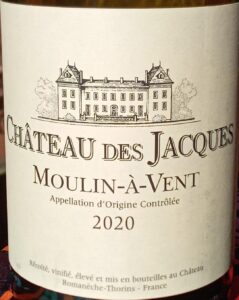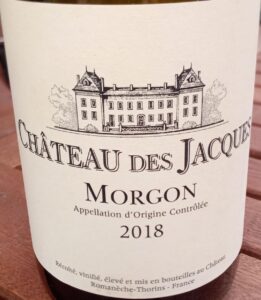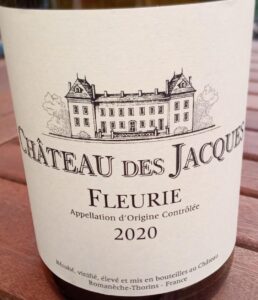“This wine could almost be mistaken for Pinot Noir in a blind tasting.”
Some months ago, a member of a private Facebook wine group I lurk in posted a picture of an old vintage of a Louis Jadot Beaujolais Village. The poster explained that the bottle had recently been gifted to them and wondered if it might still be any good. Most replies rightly stated that this was unlikely, given the wine’s age and provenance, or lack thereof. And, of course, there were a few obligatory knee-jerk declarations that nothing Louis Jadot makes and/or exports is any good, so why even bother. Those comments elicited some quick kickback from more knowledgeable wine drinkers who countered that Jadot does indeed have some worthwhile selections that are more than just forgettable plonk in their portfolio. Take Château des Jacques for instance.
According to the Kobrand Corporation website, “The historic Château des Jacques estate, located in the village of Romanèche-Thorins in the Moulin-à-Vent appellation, is widely recognized as the most prestigious estate in Beaujolais.” Whether or not this is hyperbole or actual fact, I can’t say. I can testify to the fact that I have had some good wines from this producer, starting with the 2012 Château des Jacques Moulin-à-Vent in 2015. That same wine was a thing of silky beauty when I tasted it about 6 months ago, and I can only rue the fact that I took no notes at the time. My bad.
Last week, I picked up the 2020 bottling at Plum Market, and I found it to be much to my liking, even though it may be more about promise at this early stage of development.
2020 Château des Jacques Moulin-à-Vent, 13.5% alc., $20.00: This wine could almost be mistaken for Pinot Noir in a blind tasting. It’s deep and dark and it sports few of the more obvious Gamay traits that might easily identify it. It has weight and intensity, with a substantial core of earthy black cherry and cranberry, with little hints of secondary notes that will emerge with time. That’s OK, because this can use some time in the cellar, maybe five years or more. Like any young red, this opens with air and starts to lose some of its youthful tannin-acid bite after an hour or so, and becomes more user-friendly. I wouldn’t be at all surprised if this one turned out to be just as nice as that 2012. I corked up half the bottle for my wife Kim, and she really enjoyed it the next day, so it would seem to respond positively to extended aeration. Find this wine
Plum Market on Orchard Lake has a number of these in their closeout section at the price listed, and they offer good value for the patient buyer. That’s where I found these next two selections for the same price, and while they are now sold out, I have seen the Morgon available at other retail outlets priced in the mid-to-upper $20s.
2018 Château des Jacques Morgon, 14.5% alc., $20: This may not be in the same league as the Morgons from the likes of the Foillards, laPierres or Bruns, but it more than holds its own when all things are considered. It’s another deep, dark one in both color and character, with a solid core of earthy black cherry, blackberry, beetroot and mineral. It has the kind of weight I expect from a good Morgon, being more than medium bodied, and it has the acid-tannin backbone to age for a minimum of five more years. Like the 2020 Fleurie noted below, this falls into the darker spectrum of Gamay, and I’m totally cool with that. I like it well enough already to pour a second and third glass, but I would really like to try it again in ‘27 or ‘28, when it’s had some time to rest and develop. Find this wine
2020 Château des Jacques Fleurie, 14% alc., $20.00: This Cru Beaujolais is no lightweight contender; it has some substance and depth to it. It weighs in more on the darkside in both color and character, with earthy beetroot, black cherry and black currant shaded with rhubarb and a little underbrush. This drinks well enough right now, but it’ll benefit from a few years (or more) in the cellar to tone down the ample tannins. A good glass of wine that offers decent QPR (quality-price-ratio) at the upper end of my preferred range, it likes air and I’d like to try it again when some secondary characteristics start to creep in. Find this wine
Château des Jacques’ practices have been attributed with revolutionizing the winemaking of Beaujolais. They have notably raised the bar, applying Burgundian methods of winemaking that were once traditional in the region. These include long macerations of one month, with pump-overs, to extract color, aroma and tannins from the fruit, as opposed to the regional norm of 10- to 12-day macerations. Wild yeasts are used for fermentation, and this is extended longer than is typical in Beaujolais. Aging in oak barrels is also unusual for the area; Château des Jacques’ wines are barrel aged for 10 months to lend complexity to the wines. The chateau’s barrel cellar proves that its Beaujolais wines have always been vinified like wine from the Côte D’Or. These processes create wines that can take decades of bottle aging.
Imported by Kobrand Corporation, Purchase, NY
Reporting from Day-twah,
Bastardo





Pingback: A Fleurie For Zinfan | Tasting Notes from the Underground